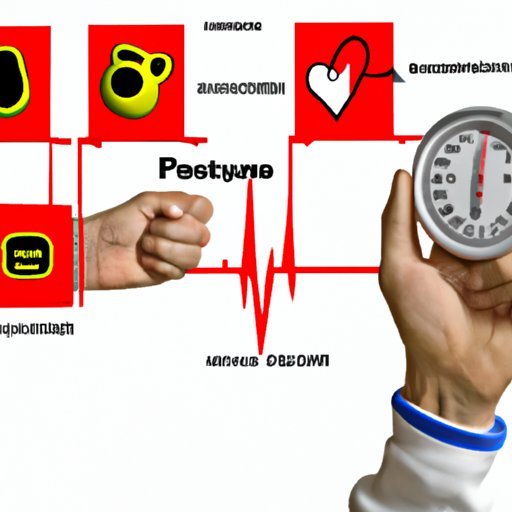Introduction
Exercise is important for overall health and wellbeing, and can have a significant impact on our cardiovascular health. One of the key aspects of this is understanding how exercise affects our blood pressure. In this article, we’ll explore the effects of exercise on blood pressure, and look at the evidence supporting its use in managing blood pressure levels.
Exploring the Effects of Exercise on Blood Pressure
The term ‘blood pressure’ refers to the amount of force that blood exerts against the walls of the arteries as it is pumped around the body. High blood pressure, or hypertension, is a serious condition that can lead to damage of the heart and arteries, and increase the risk of stroke and other cardiovascular diseases. It is therefore important to maintain healthy blood pressure levels.
So how does exercise affect our blood pressure? Generally speaking, regular exercise can help to lower blood pressure levels. However, the extent to which it does so will depend on the type of exercise being done, as well as the intensity and duration of the activity.

Understanding How Exercise Affects Blood Pressure
According to the American Heart Association (AHA), aerobic activities such as running, swimming, cycling and brisk walking are known to be particularly effective in reducing blood pressure. These activities work to strengthen the heart muscle, improve circulation and reduce the workload on the heart, all of which can help to lower blood pressure. Resistance training and stretching exercises can also be beneficial, as they help to improve flexibility and strength, which can in turn help to reduce stress levels, one of the key factors in high blood pressure.
Does Exercise Really Help to Lower Blood Pressure?
The short answer is yes. A number of studies have found that regular aerobic exercise can help to reduce both systolic and diastolic blood pressure. A study conducted in 2017 by the University of Michigan found that participants who engaged in regular aerobic exercise for 12 weeks experienced a significant decrease in systolic and diastolic blood pressure, compared to those who did not exercise.
However, there are some potential risks associated with exercising to lower blood pressure. People with existing health conditions such as heart disease, diabetes or high cholesterol should consult their doctor before engaging in any type of physical activity.

The Connection Between Exercise and Blood Pressure
Physical activity is an important part of maintaining a healthy lifestyle. Regular exercise helps to keep the body in good shape and can help to reduce stress levels, both of which can have a positive effect on our blood pressure. Studies have found that regular physical activity can help to reduce systolic and diastolic blood pressure, as well as reduce the risk of developing hypertension.
It is also important to maintain a healthy diet and get enough sleep. Eating a balanced diet, avoiding unhealthy foods and limiting alcohol consumption can all help to reduce blood pressure levels. Getting enough restful sleep is also important, as it helps to reduce stress levels and can help to regulate our hormones, which can in turn help to lower blood pressure.

How to Manage Blood Pressure Through Exercise
When it comes to managing blood pressure through exercise, it’s important to develop a safe and effective exercise plan. This should include a combination of aerobic and resistance exercises, as well as appropriate rest periods. It is also important to choose the right type of exercise for your fitness level and goals. For example, if you are just starting out, you may want to focus on low-impact activities such as walking or cycling, while more experienced exercisers may want to try more intense activities such as running or weightlifting.
Understanding the Benefits of Exercise for Blood Pressure Management
Regular physical activity is essential for keeping our blood pressure in check. Not only does it help to reduce systolic and diastolic blood pressure, but it can also help to reduce the risk of developing hypertension. Additionally, regular exercise can help to reduce stress levels and improve overall heart health, both of which can have a positive effect on our blood pressure.
It is also important to monitor your blood pressure regularly. This can help to identify any potential issues and ensure that you are taking the necessary steps to maintain healthy blood pressure levels.
Conclusion
Exercise plays an important role in maintaining healthy blood pressure levels. Regular physical activity can help to reduce systolic and diastolic blood pressure, as well as reduce the risk of developing hypertension. It is important to develop a safe and effective exercise plan that includes a combination of aerobic and resistance exercises, as well as appropriate rest periods. Additionally, it is important to maintain a healthy lifestyle, including a balanced diet and plenty of restful sleep. By taking these steps, you can help to ensure that your blood pressure remains within a healthy range.
We hope this article has provided you with an insight into the effects of exercise on blood pressure, as well as how to manage your blood pressure through exercise. We encourage readers to take steps to manage their blood pressure through exercise and maintain a healthy lifestyle for optimal heart health.
(Note: Is this article not meeting your expectations? Do you have knowledge or insights to share? Unlock new opportunities and expand your reach by joining our authors team. Click Registration to join us and share your expertise with our readers.)
